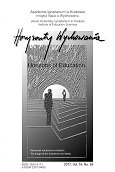Medialny obraz naukowca na przykładzie polskiej prasy opiniotwórczej
Media Image of the Scientist – the Case of the Polish Quality Press
Author(s): Bartłomiej ŁódzkiSubject(s): Social Sciences, Media studies, Communication studies
Published by: Uniwersytet Ignatianum w Krakowie
Keywords: media image; content analysis; hybrid method; quality press; scientist;
Summary/Abstract: RESEARCH OBJECTIVE: The purpose of the article is a presentation of research results and an attempt of the answer to a question how the Polish media covered issues associated with scientists. THE RESEARCH PROBLEM AND METHODS: An attempt to reconstruct the media image of the scientist, his attributes and the context in which he was presented. In the empirical part, quantitative and qualitative analysis of contents has been used. The research was carried out based on the framing theory. THE PROCESS OF ARGUMENTATION: First a legitimacy of using content analysis and assumption establishing of framing theory was explained. Next, an electronic base has been characterized, in which the texts containing the keyword “scientist” has been sought. In empirical part a research attempt and temporary spreading studied material were presented. Surnames of scientists, affiliations, university degree titles, the scientific field, the sentiment and importance of the issues (whether the contents constituted the main or marginal motif) were detailed analyzed. Finally, so-called frames of the scientist image were being analyzed. RESEARCH RESULTS: Results of the content analysis showed, that Polish, public universities were mainly exposed during the research period (80.6%). Professors representing natural sciences have most often appeared.Almost entirely an art was skipped as the scientific field. The art was almost entirely skipped as the scientific field. In more than 78% of cases the articles contained the affiliation of researchers. Despite a very varied range of research centers, the most often referred to the experts of the Polish Academy of Sciences, the Warsaw University and the Jagiellonian University.Among the non-public universities, the SWPS University has been most strongly propagated. Most articles had a neutral tone (62.6%). CONCLUSIONS, INNOVATIONS AND RECOMMENDATIONS: To a large extent the framework (prospects) in which the scientists were presented, reflect the stereotypes prevailing in Poland (professor, public college representative, discoverer, a researcher working in the laboratory). It is worthwhile continuing analyses and observation of this type in the longer perspective of the time, also including the content of the Internet.
Journal: Horyzonty Wychowania
- Issue Year: 16/2017
- Issue No: 39
- Page Range: 97-114
- Page Count: 18
- Language: Polish

